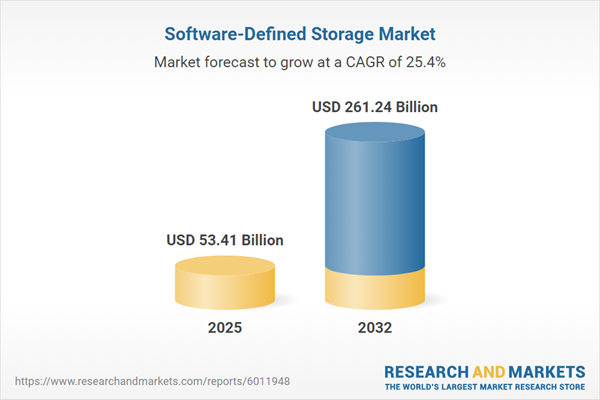Speak directly to the analyst to clarify any post sales queries you may have.
Software-defined storage is transforming enterprise infrastructure, allowing leaders to modernize how data is managed and adapt rapidly to business and technology changes. This approach supports compliance needs, increases operational agility, and strengthens resilience as organizations pursue strategic digital initiatives in a shifting IT environment.
Market Snapshot: Software-Defined Storage Market Size and Growth
The software-defined storage market reached USD 42.74 billion in 2024 and is projected to grow to USD 53.41 billion by 2025, reflecting a compound annual growth rate (CAGR) of 25.39%. This expansion is driven by enterprises seeking technology that aligns with their evolving operational requirements, emphasizing flexibility and ongoing advancements in efficiency. Demand is further supported by the integration of hybrid cloud solutions, enhanced compliance workflows, and digital transformation projects. As more organizations focus on platform modernization, storage decisions play an increasingly pivotal role in supporting overall business strategies and maintaining strong competitive positioning.
Scope & Segmentation: Strategic Landscape for Senior Leaders
A comprehensive view of the software-defined storage market empowers executives to prioritize investments, procurement strategies, and operational changes suited to industry objectives and global dynamics. The segments below outline key considerations for stakeholders:
- Component: Hardware, managed services, professional services, and software each provide targeted, scalable options for managing enterprise workloads, supporting integration with existing systems across varied environments.
- Deployment Model: Cloud, on-premises, or hybrid deployments allow organizations to match storage strategies with performance, compliance, and governance needs, adapting models as regulatory or operational demands evolve.
- Storage Type: Block storage powers high-performance transactions, file storage drives collaboration and workflow productivity, while object storage scales for unstructured data and analytics use cases.
- Application: Use cases encompass archival, backup and recovery, analytics support, real-time operations, and document management—addressing both core business continuity and new data-driven growth areas.
- End User Vertical: Banks, governments, healthcare institutions, IT and telecom providers, retailers, and e-commerce companies each require solutions adapted for industry-specific compliance, security, and integration.
- Organization Size: Solutions scale flexibly for small organizations, mid-market firms, and global enterprises, supporting resilience and resource optimization at any stage of growth.
- Architecture: Controller-based and host-based options allow businesses to optimize for scalability, performance, and investment efficiency, aligning storage design with targeted IT roadmaps.
- Delivery Model: Enterprises can leverage converged appliances, hyperconverged infrastructure, or modular licensing for rapid integration and operational agility across deployment sites.
- Regional Coverage: Adoption trends vary among the Americas, Europe, Middle East and Africa, and Asia-Pacific, shaped by regional supply chain factors and distinct regulatory environments.
- Company Coverage: Major global providers—such as Dell Technologies Inc., NetApp, Hewlett Packard Enterprise, IBM, Hitachi Vantara, Huawei, Pure Storage, Cisco Systems, VMware, and Fujitsu Limited—drive innovation and deliver solutions recognized for reliability.
Key Takeaways: Strategic Insights for Senior Leaders
- Automation and orchestration capabilities streamline processes, reducing manual efforts and helping mitigate operational risk, especially in complex, distributed IT ecosystems.
- Embracing multi-cloud and cloud-native deployment strategies enhances flexibility and supports evolving compliance and business priorities in dynamic markets.
- Adoption of AI-powered analytics and automated, self-healing management enhances system responsiveness, enabling organizations to extract greater value from their data assets while minimizing unplanned downtime.
- Compatibility with containerized workloads and edge computing extends deployment flexibility, bolstering business continuity and adaptiveness across geographically diverse operations.
- Dynamic and adaptable data management approaches equip organizations to respond swiftly to new regulatory requirements and changing business conditions, reinforcing operational agility.
- Ongoing vendor investments in AI-driven management modules reinforce proactive adaptation to emerging technology and regulatory challenges, further supporting enterprise objectives.
Tariff Impact: Responding to Regulatory Shifts
Projected changes to United States tariff regulations in 2025 will directly affect procurement and supply-chain strategies for storage hardware. Many enterprises are reducing exposure to these risks by diversifying vendor relationships and adopting software-focused deployment models, which enhances operational resilience in the face of evolving regulatory requirements.
Methodology & Data Sources
This report leverages direct executive interviews, expert guidance from leading technology strategists, and a comprehensive review of industry and regulatory literature. This approach ensures market intelligence that is actionable, current, and precisely tailored for IT and procurement decision-makers.
Why This Report Matters
- Supports risk-aware technology investment decisions and supplier selection across diverse sectors and regions.
- Facilitates development of robust migration and cloud adoption strategies to maintain business resilience amid global IT disruptions.
- Delivers frameworks enabling procurement leaders to build agile, resilient supply chains that can readily adjust to changing tariff and regulatory contexts.
Conclusion
Senior executives can rely on this analysis to guide adaptive, future-ready storage strategies that keep pace with technological change and regulatory developments, positioning their organizations for sustained operational success.
Additional Product Information:
- Purchase of this report includes 1 year online access with quarterly updates.
- This report can be updated on request. Please contact our Customer Experience team using the Ask a Question widget on our website.
Table of Contents
3. Executive Summary
4. Market Overview
7. Cumulative Impact of Artificial Intelligence 2025
Companies Mentioned
The companies profiled in this Software-Defined Storage market report include:- Dell Technologies Inc.
- NetApp, Inc.
- Hewlett Packard Enterprise Company
- International Business Machines Corporation
- Hitachi Vantara Corporation
- Huawei Technologies Co., Ltd.
- Pure Storage, Inc.
- Cisco Systems, Inc.
- VMware, Inc.
- Fujitsu Limited
Table Information
| Report Attribute | Details |
|---|---|
| No. of Pages | 194 |
| Published | November 2025 |
| Forecast Period | 2025 - 2032 |
| Estimated Market Value ( USD | $ 53.41 Billion |
| Forecasted Market Value ( USD | $ 261.24 Billion |
| Compound Annual Growth Rate | 25.3% |
| Regions Covered | Global |
| No. of Companies Mentioned | 11 |









